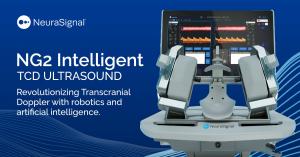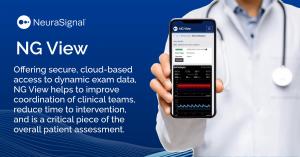
NeuraSignal’s Automated TCD Proven to Streamline PFO Screening in New Real-World Publications
NeuraSignal is proud to announce the publication of two pivotal real-world clinical studies.
LOS ANGELES, CA, UNITED STATES, April 10, 2025 /EINPresswire.com/ -- NeuraSignal is proud to announce the publication of two pivotal real-world clinical studies validating the use of robot-assisted transcranial Doppler (raTCD) for stroke and cardiac risk assessment. These peer-reviewed studies reinforce the growing role of automated TCD as a vital diagnostic tool in both neurovascular and cardiovascular care.
The studies demonstrate that raTCD significantly outperforms traditional methods in detecting patent foramen ovale (PFO) and other vascular shunts — critical risk factors in patients with stroke. The compelling findings support the integration of automated TCD into standard stroke workflows, offering clinicians a more accurate, more reliable, and non-invasive approach to identifying critical risk factors.
Study #1 – Single-Center, Real-World Validation of raTCD for PFO Detection
Lead Author: Ruchir Shah, MD
Published in: Frontiers in Neurology
Key Findings:
• raTCD detected 1.9X more PFO cases than transthoracic echocardiography (TTE), making it a more effective screening tool.
• Established raTCD as a critical element of stroke workup
• Demonstrated increased PFO closures compared to traditional TTE bubble-only workflow
• This study builds upon the BUBL Trial (NCT04604015), further validating robotic TCD as a frontline diagnostic for stroke risk assessment.
Full study details: NeuraSignal Announces Groundbreaking Study on Robotic Transcranial Doppler (raTCD) for PFO Detection Accepted at ISC 2025
Study #2 – Revolutionizing Stroke Diagnosis with raTCD
Lead Author: Dr. Ira Chang, MD
Published in: Frontiers in Neurology
Key Findings:
• raTCD offers a fully automated, hands-free approach, removing operator variability in the diagnosis of Right to Left shunts, including those caused by patent foramen ovale (PFO).
• By providing early and reliable shunt size data to generate consistent clinical criteria, raTCD streamlined PFO assessment.
• The study reinforces raTCD as a first-line tool for PFO screening in patients with stroke.
Full study details: Revolutionizing Stroke Diagnosis: Robotic Automated Transcranial Doppler for Detecting Right-to-Left Shunt
A Milestone for Stroke and Cardiology Communities
“These studies mark a major step forward in the way we assess PFO in patients with stroke,” said Dr. Ruchir Shah, first author of the real-world CommonSpirit study. “The data clearly demonstrate that robot-assisted TCD should be a standard part of the diagnostic workflow for both stroke neurologists and cardiologists evaluating cryptogenic stroke patients.”
Dr. Ira Chang, author of the Frontiers in Neurology study, added: “Automated TCD removes the barriers of operator-dependent variability, making cerebral blood flow monitoring and PFO assessment more accessible and clinically reliable than ever before. This is a game-changer for stroke care.”
NeuraSignal: Advancing Stroke Assessment and Management with Automated Ultrasound
With these groundbreaking studies, NeuraSignal continues to push the boundaries of neurovascular and cardiac imaging, ensuring that clinicians have access to fast, accurate, and non-invasive tools for stroke prevention and patient care.
Learn more about NeuraSignal and NG2 Intelligent Ultrasound:
🔗 www.neurasignal.com
Eric Yen
NeuraSignal Inc.
+1 415-271-8358
email us here
Visit us on social media:
X
LinkedIn
Distribution channels: Culture, Society & Lifestyle, Emergency Services, Healthcare & Pharmaceuticals Industry, Science, Technology
Legal Disclaimer:
EIN Presswire provides this news content "as is" without warranty of any kind. We do not accept any responsibility or liability for the accuracy, content, images, videos, licenses, completeness, legality, or reliability of the information contained in this article. If you have any complaints or copyright issues related to this article, kindly contact the author above.
Submit your press release



